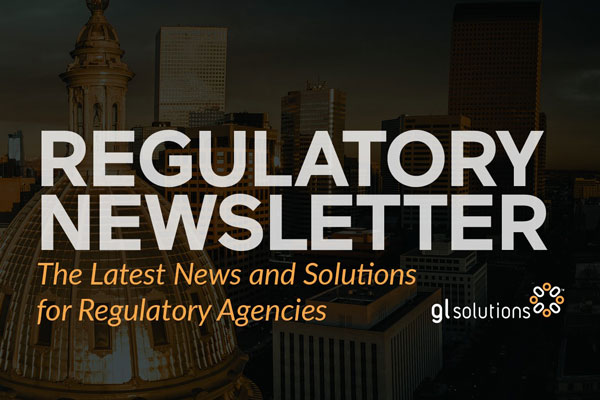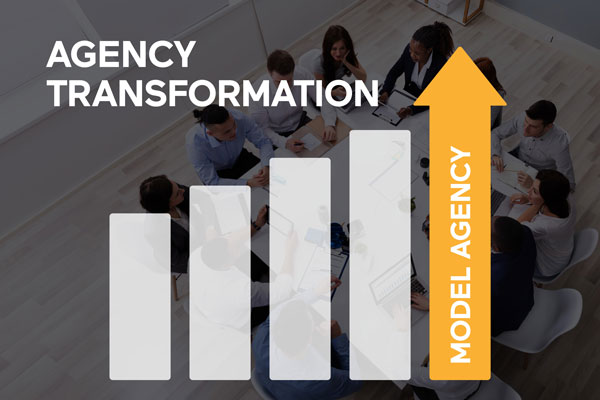Five Phases of an Optimal State Government Agency
Learn the five phases of transformation for an optimal state government agency, each phase designed to build upon the successes of the previous stage. Phases help your regulatory agency make changes gradually, reengineering your business processes over time, supporting the workflow of your agency. Discover what phase your agency falls into and learn concrete steps to move through the phases towards the final phase—model agency.
Take our Optimal Agency Quiz for a personalized assessment.
Phase 1: Capacity Building
In Capacity Building Phase 1, your regulatory agency establishes the objectives and mission of the agency. This transformation exercise also includes evaluating your agency’s leadership capacity and staff performance. Your agency must formulate a high-level strategic plan to achieve process standardization, including staff demands, project management, schedules, and costs.
Define Agency Mission and Objectives
- Create a mission statement that clearly outlines your regulatory agency’s purpose and goals.
- Identify short-term and long-term objectives.
Evaluate Leadership Capacity
- Assess the strengths and weaknesses of current leadership.
- Provide leadership training and development programs.
Assess Staff Performance
- Implement performance evaluations and feedback systems.
- Identify additional skills needed and provide training.
Formulate High-Level Plans
- Develop a strategic plan that outlines process standardization.
- Create project management frameworks to streamline operations.
Phase 2: Process Standardization
In Process Standardization Phase 2, your regulatory agency creates standard processes for staff to follow. Step-by-step guides help your employees accurately follow these processes. Your agency must understand how the agency ecosystem operates and how those services are managed and processed.
Evaluate Agency Operations
- Map out current operational processes to identify inefficiencies.
- Standardize processes to ensure consistency and reliability.
Manage and Process Services
- Develop a system for managing service requests and processing tasks efficiently.
- Utilize technology to automate repetitive tasks where possible.
Develop and Implement Business Process Guides
- Develop detailed business process guides for all key operational processes.
- Ensure the guides are easily accessible to all staff.
- Conduct training sessions to ensure all staff understand and can implement operational procedures.
Automate Routine Activities
- Utilize batch processing and automation tools for repetitive tasks.
- Free up staff time to focus on strategic and analytical work.
Phase 3: Customer Service
Customer Service Phase 3 is characterized by promoting all public communication toward online self-service. This includes applications, permits, licenses, CE, background checks, enforcement, verification, status of licensure, and claim status. In addition, your agency websites should be mobile-enabled to support data entry for remote functions, such as investigations, surveys, and inspections.
Promote Online Self-Service
- Develop user-friendly online portals that can be accessed 24/7 for license renewals and licensure verification.
- Implement live chat support and comprehensive FAQs on the website.
- Ensure all essential services are accessible online.
- Use social media platforms to keep the public informed.
Enable Mobile Access
- Optimize agency websites for mobile devices and adhere to website accessibility requirements.
- Provide mobile apps for remote data entry and service access.
Facilitate Remote Functions
- Equip field staff with mobile devices to access and update data remotely.
- Develop tools for remote investigations, surveys, and inspections.
Phase 4: Integrated Service
In Integrated Service Phase 4, your agency embraces digital functionality and communication. Your agency provides online self-service to constituents, including an online communication portal. Data interfaces provide your staff with automatic alerts to address situations in a timely manner. Staff dashboards enable all staff, including managers, to see staff to-do lists and keep metrics on staff performance related to these tasks.
Embrace Digital Communication
- Establish an online communication portal for seamless interaction with constituents.
- Utilize email and SMS notifications for timely updates and alerts.
Implement Data Interfaces
- Develop interfaces that integrate various data sources for comprehensive insights.
- Set up automatic alerts for critical issues and timely responses.
Create Staff Dashboards
- Design dashboards that display real-time data and performance metrics.
- Provide managers with tools to monitor staff performance and workload.
Enhance Online Self-Service
- Expand online service offerings to cover more functions and services.
- Continuously improve the user experience of online platforms.
Phase 5: Model Agency
In Model Agency Phase 5, your agency focuses on gathering data and measuring performance. The system now takes care of routine activities with tools like batch processing, enabling your staff to focus on work that requires analysis and discretion. Your agency uses clearly defined Key Performance Indicators (KPIs)—measures of success—to accurately reflect the agency’s effectiveness and accomplishments. Your agency reviews reports of these measures on a regular basis to help your agency improve.
Focus on Data Gathering
- Implement robust data collection systems to capture relevant metrics.
- Use data analytics tools to gain insights and make informed decisions.
Measure Performance with KPIs
- Define KPIs that align with the agency’s goals and objectives.
- Regularly monitor and review performance against these KPIs.
Regularly Review and Improve
- Conduct regular performance reviews and generate detailed reports.
- Use insights from performance data to drive continuous improvement efforts.
Why Phases?
Phases help your regulatory agency make changes gradually, reengineering your business processes over time—supporting the workflow of your agency. With each new phase, your agency benefits from accomplishing certain goals, as well as setting new goals to work towards. Additionally, phasing in change helps to space out the financial impact on your agency, as well as the budgeting and legislative processes.
Gradual Implementation
- Allows for a smoother transition and adjustment period for staff.
- Reduces the risk of disruption to agency operations.
Goal Achievement and Setting
- Provides clear milestones and objectives to work towards.
- Encourages continuous progress and development.
Financial and Budgeting Benefits
- Spreads out costs over time, making budgeting more manageable.
- Facilitates easier approval of budget requests and funding for your rapidly evolving needs.
GL Solutions empowers regulatory agencies to achieve agency transformation and modernization by providing an innovative regulatory software solution that streamlines operations, enhances efficiency, and improves customer service. With a focus on digital functionality and communication, our GL Suite platform offers comprehensive tools for process standardization, online self-service, and data-driven decision-making. Our tailored approach helps state government agencies transition smoothly through different phases of development, ultimately achieving a model agency status characterized by optimized performance and effectiveness.


